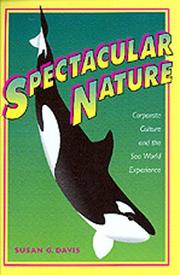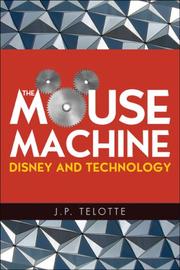| Listing 1 - 10 of 14 | << page >> |
Sort by
|
Book
ISBN: 303111132X 3031111311 Year: 2023 Publisher: Cham, Switzerland : Springer Nature Switzerland AG,
Abstract | Keywords | Export | Availability | Bookmark
 Loading...
Loading...Choose an application
- Reference Manager
- EndNote
- RefWorks (Direct export to RefWorks)
This book offers a comprehensive, multidisciplinary introduction to theme parks and the field of theme park studies. It identifies and discusses relevant economic, social, and cultural as well as medial, historical, and geographical aspects of theme parks worldwide, from the big international theme park chains to smaller, regional, family-operated parks. The book also describes the theories and methods that have been used to study theme parks in various academic disciplines and reviews the major contexts in which theme parks have been studied. By providing the necessary backgrounds, theories, and methods to analyze and understand theme parks both as a business field and as a socio-cultural phenomenon, this book will be a great resource to students, academics from all disciplines interested in theme parks, and professionals and policy-makers in the leisure and entertainment as well as the urban planning sector.
Periodical
Publisher: [Place of publication not identified] : MarketLine, a Progressive Digital Media business,
Abstract | Keywords | Export | Availability | Bookmark
 Loading...
Loading...Choose an application
- Reference Manager
- EndNote
- RefWorks (Direct export to RefWorks)
Book
ISBN: 1849664919 1849666660 9786613479174 1849666679 1283479176 9781849666671 9781283479172 9781849664912 9781849666718 1849666717 9781849664912 9781849666664 Year: 2012 Publisher: London Bloomsbury Academic, an imprint of Bloomsbury Pub.
Abstract | Keywords | Export | Availability | Bookmark
 Loading...
Loading...Choose an application
- Reference Manager
- EndNote
- RefWorks (Direct export to RefWorks)
The study investigates the cultural production of the visual iconography of popular pleasure grounds from the eighteenth century pleasure garden to the contemporary theme park. Deborah Philips identifies the literary genres, including fairy tale, gothic horror, Egyptiana and the Western which are common to carnival sites, tracing their historical transition across a range of media to become familiar icons of popular culture.Though the bricolage of narratives and imagery found in the contemporary leisure zone has been read by many as emblematic of postmodern culture, the author argues that the
Amusement parks -- History. --- Amusement parks -- Social aspects. --- Fairs. --- Social Sciences --- Recreation & Sports --- Amusement parks --- Leisure --- History. --- Free time (Leisure) --- Leisure time --- Funparks --- Theme parks --- Recreation --- Amusements --- Parks --- Amusement rides
Book
ISBN: 0821446371 9780821446379 9780821423233 0821423231 Year: 2018 Publisher: Athens
Abstract | Keywords | Export | Availability | Bookmark
 Loading...
Loading...Choose an application
- Reference Manager
- EndNote
- RefWorks (Direct export to RefWorks)
"Dolly Parton isn't just a country music superstar. She has built an empire. At the heart that empire is Dollywood, a 150-acre fantasy land that hosts three million people a year. Parton's prodigious talent and incredible celebrity has allowed her to turn her hometown into one of the most popular tourist destinations in America. The crux of Dollywood's allure is its precisely calibrated Appalachian image, itself drawn from Parton's very real hardscrabble childhood in the mountains of east Tennessee. What does Dollywood have to offer besides entertainment? What do we find if we take this remarkable place seriously? How does it both confirm and subvert outsiders' expectations of Appalachia? What does it tell us about the modern South, and in turn what does that tell us about America at large? How is regional identity molded in service of commerce, and what is the interplay of race, gender, and class when that happens? In Gone Dollywood, Graham Hoppe blends tourism studies, celebrity studies, cultural analysis, folklore, and the acute observations and personal reflections of longform journalism into an unforgettable interrogation of Southern and American identity"--
Amusement parks --- Parton, Dolly. --- Dollywood (Pigeon Forge, Tenn.) --- Southern States --- Social life and customs. --- Parton, Dolly
Book
ISBN: 9780813048901 0813048907 9781306553162 1306553164 9780813049120 0813049121 0813050219 9780813050218 0813065321 Year: 2014 Publisher: Gainesville, Florida : University Press of Florida,
Abstract | Keywords | Export | Availability | Bookmark
 Loading...
Loading...Choose an application
- Reference Manager
- EndNote
- RefWorks (Direct export to RefWorks)
The book focuses on Disney World as a locus for understanding Walt Disney's vision and goal to transport visitors to a different world.
Amusement parks --- Disney, Walt, --- Walt Disney World (Fla.) --- Disney World (Fla.) --- Magic Kingdom (Fla.) --- EPCOT Center (Fla.) --- History.
Book
ISBN: 1282190547 9786612190544 1443806714 9781443806718 9781282190542 Year: 2007 Publisher: Newcastle upon Tyne Cambridge Scholars Pub.
Abstract | Keywords | Export | Availability | Bookmark
 Loading...
Loading...Choose an application
- Reference Manager
- EndNote
- RefWorks (Direct export to RefWorks)
Being a special kind of landscape, the theme park has become one of major subjects in interdisciplinary studies and received increasing scholarly attention in the past few decades. Perspectives have varied from American approaches which treat the theme park as the production base of the American Dream to various interpretation of the tourist space in semiotic, structural and post-modernistic approaches. Other studies of the theme park have been conducted in a practical way with a focus in eco...
Amusement parks --- Globalization --- Global cities --- Globalisation --- Internationalization --- International relations --- Anti-globalization movement --- Funparks --- Theme parks --- Amusements --- Parks --- Amusement rides --- Social aspects --- Overseas Chinese Town (Shenzhen Shi, China)
Book
ISBN: 0231538197 9780231538190 9780231165723 0231165722 9780231165730 0231165730 Year: 2014 Publisher: New York, NY : Columbia University Press,
Abstract | Keywords | Export | Availability | Bookmark
 Loading...
Loading...Choose an application
- Reference Manager
- EndNote
- RefWorks (Direct export to RefWorks)
Featuring a stunning gallery of portraits by the world's finest poets, essayists, and fiction writers--including Walt Whitman, Stephen Crane, José Martí, Maxim Gorky, Federico García Lorca, Isaac Bashevis Singer, E. E. Cummings, Djuna Barnes, Colson Whitehead, Robert Olen Butler, and Katie Roiphe--this anthology is the first to focus on the unique history and transporting experience of a beloved fixture of the New York City landscape.Moody, mystical, and enchanting, Coney Island has thrilled newcomers and soothed native New Yorkers for decades. With its fantasy entertainments, renowned beach foods, world-class boardwalk, and expansive beach, it provides a welcome respite from the city's dense neighborhoods, unrelenting traffic, and somber grid. Coney Island has long offered a kaleidoscopic panorama of people, places, and events, creating, as Lawrence Ferlinghetti once wrote, "a Coney Island of the mind." This anthology captures the highs and lows of that sensation, with works that imagine Coney Island as a restful resort, a playground for the masses, and a symbol of America's democratic spirit, as well as a Sodom by the sea, a garish display of capitalist excess, and a paradigm of urban decay. As complex as the city of which it is a part, Coney Island engenders limitless perspectives, a composite inspiring everyone who encounters it to sing its electric song.

ISBN: 052091953X 058504113X 9780520919532 9780585041131 0520200314 0520209818 9780520200319 9780520209817 Year: 1997 Publisher: Berkeley, Calif. University of California Press
Abstract | Keywords | Export | Availability | Bookmark
 Loading...
Loading...Choose an application
- Reference Manager
- EndNote
- RefWorks (Direct export to RefWorks)
Amusement parks --- Corporate culture --- NON-CLASSIFIABLE. --- Culture, Corporate --- Institutional culture --- Organizational culture --- Corporations --- Organizational behavior --- Business anthropology --- Funparks --- Theme parks --- Amusements --- Parks --- Amusement rides --- Economic aspects --- California --- San Diego. --- Social aspects --- San Diego --- Sociological aspects --- Sociology of culture

ISBN: 9780252033278 0252033272 9780252075407 0252075404 9786613895660 0252092635 1283583216 9780252092633 9781283583213 6613895660 Year: 2008 Publisher: Urbana
Abstract | Keywords | Export | Availability | Bookmark
 Loading...
Loading...Choose an application
- Reference Manager
- EndNote
- RefWorks (Direct export to RefWorks)
Throughout Disney's phenomenally successful run in the entertainment industry, the company has negotiated the use of cutting-edge film and media technologies that, J. P. Telotte argues, have proven fundamental to the company's identity. Disney's technological developments include the use of stereophonic surround sound for Fantasia, experimentation with wide-screen technology, inaugural adoption of three-strip Technicolor film, and early efforts at fostering depth in the animated image.Telotte also chronicles Disney's partnership with television, development of the theme park, and depiction of technology in science fiction narratives. An in-depth discussion of Disney's shift into digital filmmaking with its Pixar partnership and an emphasis on digital special effects in live-action films, such as the "Pirates of the Caribbean" series, also highlight the studio's historical investment in technology. By exploring the technological context for Disney creations throughout its history, "The Mouse Machine" illuminates Disney's extraordinary growth into one of the largest and most influential media and entertainment companies in the world.
Amusement parks --- Motion picture industry --- Television --- Technological innovations. --- Walt Disney Company. --- Funparks --- Theme parks --- Film industry (Motion pictures) --- Moving-picture industry --- Disney Studio --- 迪斯尼公司 --- Mei guo di shi ni gong si --- 美國迪士尼公司 --- Amusements --- Parks --- Amusement rides --- Cultural industries --- Walt Disney Productions --- Technological innovations --- E-books --- 21st Century Fox (Firm) --- Industrie du cinéma --- Télévision --- Parcs d'attractions --- Innovation.

ISBN: 1282355732 9786612355738 0520910427 9780520910423 0520068505 0520071166 9780520068506 Year: 1990 Publisher: CA University of California Press
Abstract | Keywords | Export | Availability | Bookmark
 Loading...
Loading...Choose an application
- Reference Manager
- EndNote
- RefWorks (Direct export to RefWorks)
An early cameo of Latin American surrealism, Rosamel del Valle's erotic narrative of ecstasy and perdition creates the rhythm of the dream and the tempo of madness. Intermittently a waiflike young woman, Eva, intrudes into the daily routine of the writer. Her appearances are marked by a circle of red and the vision of a deep well with a star hanging over it. A tone poem of surrealist encounter, pursuit, and loss, Eva y la Fuga was written in 1930 and finally published posthumously in 1970, by Monte Avila Press in Venezuela. Anna Balakian offers here the first translation of the work into any other language. She brilliantly conveys in English the author's highly metaphoric language and the immediacy of surrealist experience, signaled in the narrative by frequent lapses into a haunting present tense.On their walks through the streets of Santiago, Eva and the narrator mingle in the fiesta atmosphere of the Chilean Amusement Park, with its gigantic Ferris Wheel. Bits of real-life dialogue float through the air. But the couple move on different wavelengths from the crowd and often from each other. Passing in and out of his life, Eva exercises a hypnotic fascination over the writer and makes an equally profound impression on the reader. This narrative is in the same genre as Gerard de Nerval's Aurélia, André Breton's Nadja, and Michel Leiris's Aurora, and should be counted among the most compelling works of twentieth-century surrealist literature.
Chilean literature --- 20th century. --- 1930s. --- art history. --- art movements. --- author. --- daily life. --- day to day. --- dreamlike. --- ecstasy. --- erotic. --- ferris wheel. --- figurative language. --- grief. --- latin america. --- latin american. --- lesser known. --- literary movements. --- loss. --- mental health. --- metaphors. --- poetry. --- posthumous. --- santiago. --- slice of life. --- surrealism. --- tone poem. --- translation. --- writer. --- young woman. --- Amusement parks --- Courtship --- Loss (Psychology)
| Listing 1 - 10 of 14 | << page >> |
Sort by
|

 Search
Search Feedback
Feedback About UniCat
About UniCat  Help
Help News
News